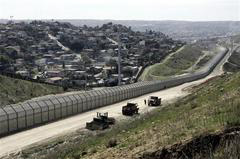 |
 |
 |
 News from Around the Americas | November 2006 News from Around the Americas | November 2006  
Feds: Border Security Costs Could Soar
 Associated Press Associated Press


| | The U.S.-Mexico border fence stretches 14 miles inland separating San Diego and Tijuana, Mexico, in this March 27, 2006, file photo. The homes at left are in Tijuana. This section of fence will become the western-most end of the fence when an additional 700 miles of non-contiguous fencing, which was recently approved by Congress, is erected between California and Texas. With the Democratic Party in control of Congress, Hispanic political activists are preparing for a big push toward reform, which would include repeal of the Secure Fence Act. (AP/Lenny Ignelzi) |
Electronic monitoring and other steps for enhancing surveillance along the southwestern border could cost 15 times the initial $2 billion estimate, the Homeland Security Department's inspector general says.

"Early forecasts and estimates of the program's value range from $8 billion to $30 billion," Richard L. Skinner said in an audit report.

The estimate raised new questions about the viability of efforts by President Bush and Congress to revamp immigration policies. The Republican-led Congress demanded that a first step include efforts to improve security along the U.S. borders.

The contract for a "virtual fence" of new cameras, surveillance technology and revamped procedures for border agents was awarded in September to the Boeing Co. The first phase of the program is planned for a 28-mile stretch along the Arizona border near Tucson and is due to be completed in June.

The figures exclude the costs of about 700 miles of additional physical border fencing that Bush signed into law in September.

Homeland Security Department spokesman Russ Knocke said only the money for the Tucson-area phase of the project, $67 million, has been set aside from agency funds so far.

"I'm not sure where his numbers are coming from," Knocke said of Skinner's estimate. He said the agency was open to listening to Skinner's ideas on how to strengthen oversight of the program.

"We've been very clear from the very beginning," Knocke said. "We were going to build a little and prove it before we build more."

"The bottom line is there isn't a number," said Rep. Mark Souder, R-Ind. He was critical of how the contract was awarded and the program is being managed. He noted that estimates can change, but that Boeing must have had a cost estimate when it bid on the contract.

Souder said the plan to go ahead with just the 28-mile stretch near Tucson without a clearer overall plan was like building a house without a plan or cost estimate while saying, "we're getting along really well with the downstairs bathroom."

A Boeing spokeswoman noted that the company is "on a contract for $67 million at this time," with three one-year options. She declined to answer other questions.

Rep. Bennie Thompson, D-Miss., in line to become chairman of the House Homeland Security Committee next year, said he is "troubled that we have not seen a detailed rendering of the department's strategy."

Bush and Congress have approved $1.2 billion for the border security program, but $950 million of that cannot be tapped until the department provides Congress with a report on how it will spend the money, Knocke said.

On Wednesday, Skinner told the House Homeland Security Committee's management subcommittee that the type of contract awarded to Boeing for the border program creates additional risks that, "unless properly managed, threaten achievement of cost, schedule, performance, and, ultimately, mission objectives." | 
 | |
 |



